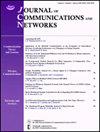Degree-degree correlated low-density parity-check codes and their extensions
IF 3.2
3区 计算机科学
Q2 COMPUTER SCIENCE, INFORMATION SYSTEMS
引用次数: 0
Abstract
Most existing work on analyzing the performance of a random ensemble of low-density parity-check (LDPC) codes assumes that the degree distributions of the two ends of a randomly selected edge are independent. In this paper, we go one step further by considering ensembles of LDPC codes with degree-degree correlations. We propose two methods to construct such an ensemble of degree-degree correlated LDPC codes and derive a system of density evolution equations for these codes over a binary erasure channel (BEC). By conducting extensive numerical experiments, we demonstrate how the degree-degree correlation affects the performance of LDPC codes. Our numerical results suggest that LDPC codes with negative degree-degree correlation could enhance the maximum tolerable erasure probability. Moreover, increasing the negative degree-degree correlation could facilitate better unequal error protection (UEP) design. In the final part of our extension efforts, we extend degree-degree correlated LDPC codes to multi-edge type LDPC codes and leverage these to construct convolutional LDPC codes.度相关低密度奇偶校验码及其扩展
现有的低密度奇偶校验(LDPC)码随机集合性能分析工作大多假设随机选取的边两端的度数分布是独立的。在本文中,我们更进一步,考虑了具有度数相关性的 LDPC 码集合。我们提出了构建这种度数相关 LDPC 码集合的两种方法,并推导出了这些码在二进制擦除信道 (BEC) 上的密度演化方程组。通过大量的数值实验,我们证明了度数相关性如何影响 LDPC 码的性能。我们的数值结果表明,具有负度相关性的 LDPC 码可以提高最大可容忍擦除概率。此外,增加负度相关性还有助于更好地设计不等误保护(UEP)。在扩展工作的最后一部分,我们将度相关 LDPC 码扩展到多边型 LDPC 码,并利用这些码构建卷积 LDPC 码。
本文章由计算机程序翻译,如有差异,请以英文原文为准。
求助全文
约1分钟内获得全文
求助全文
来源期刊
CiteScore
6.60
自引率
5.60%
发文量
66
审稿时长
14.4 months
期刊介绍:
The JOURNAL OF COMMUNICATIONS AND NETWORKS is published six times per year, and is committed to publishing high-quality papers that advance the state-of-the-art and practical applications of communications and information networks. Theoretical research contributions presenting new techniques, concepts, or analyses, applied contributions reporting on experiences and experiments, and tutorial expositions of permanent reference value are welcome. The subjects covered by this journal include all topics in communication theory and techniques, communication systems, and information networks. COMMUNICATION THEORY AND SYSTEMS WIRELESS COMMUNICATIONS NETWORKS AND SERVICES.

 求助内容:
求助内容: 应助结果提醒方式:
应助结果提醒方式:


